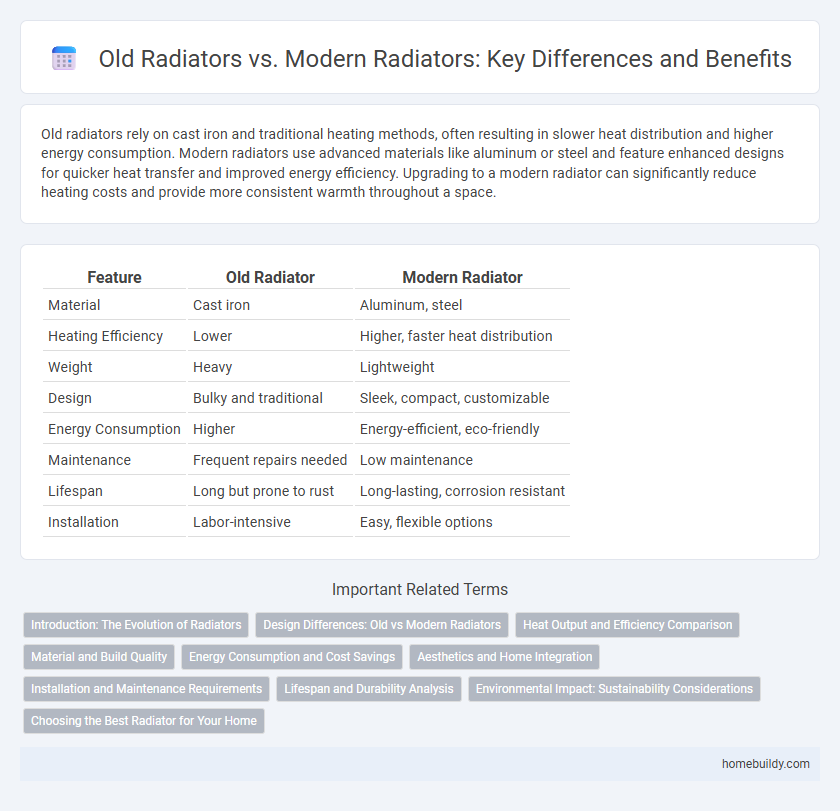Old radiators rely on cast iron and traditional heating methods, often resulting in slower heat distribution and higher energy consumption. Modern radiators use advanced materials like aluminum or steel and feature enhanced designs for quicker heat transfer and improved energy efficiency. Upgrading to a modern radiator can significantly reduce heating costs and provide more consistent warmth throughout a space.
Table of Comparison
| Feature | Old Radiator | Modern Radiator |
|---|---|---|
| Material | Cast iron | Aluminum, steel |
| Heating Efficiency | Lower | Higher, faster heat distribution |
| Weight | Heavy | Lightweight |
| Design | Bulky and traditional | Sleek, compact, customizable |
| Energy Consumption | Higher | Energy-efficient, eco-friendly |
| Maintenance | Frequent repairs needed | Low maintenance |
| Lifespan | Long but prone to rust | Long-lasting, corrosion resistant |
| Installation | Labor-intensive | Easy, flexible options |
Introduction: The Evolution of Radiators
Traditional old radiators, often made of cast iron, provided reliable but slow and uneven heat distribution, relying on natural convection and radiation. Modern radiators, typically constructed from lightweight steel or aluminum, incorporate advanced technologies such as convectors and thermostatic controls for efficient, rapid heating and energy conservation. The evolution reflects significant improvements in materials, design, and energy efficiency to meet contemporary heating demands.
Design Differences: Old vs Modern Radiators
Old radiators typically feature cast iron construction with ornate, bulky designs emphasizing durability and classic aesthetics. Modern radiators use lightweight materials like aluminum or steel and showcase sleek, minimalist forms prioritizing energy efficiency and space-saving installation. Advanced technologies in modern designs also allow for better heat distribution and customizable styles to match contemporary interior decor.
Heat Output and Efficiency Comparison
Old radiators typically use cast iron, which retains heat longer but heats up slowly, resulting in lower overall efficiency compared to modern radiators made from aluminum or steel with faster heat output. Modern radiators offer improved energy efficiency through enhanced convection and design optimizations, allowing them to distribute heat more quickly and maintain consistent room temperatures while using less fuel. Heat output from modern radiators is usually higher per unit size, making them more suitable for energy-efficient homes and reducing overall heating costs.
Material and Build Quality
Old radiators were predominantly made from cast iron, known for its excellent heat retention but heavy weight and susceptibility to rust over time. Modern radiators utilize materials such as aluminum and steel, which offer superior heat conductivity, lighter weight, and enhanced corrosion resistance for longer durability. Advanced manufacturing techniques in contemporary models ensure enhanced build quality with precise heat distribution and easier installation.
Energy Consumption and Cost Savings
Old radiators typically consume more energy due to inefficient heat transfer and outdated materials, resulting in higher utility bills. Modern radiators incorporate advanced technology like improved convection mechanisms and low-water content designs to optimize energy efficiency and significantly reduce heating costs. Investing in updated radiator systems can lead to immediate cost savings and long-term energy consumption reduction.
Aesthetics and Home Integration
Old radiators feature ornate cast-iron designs with intricate patterns that add a vintage charm and serve as a focal point in traditional interiors. Modern radiators prioritize sleek, minimalist aesthetics with smooth finishes and slim profiles, blending seamlessly into contemporary home designs. Enhanced customization options in modern radiators allow homeowners to choose colors, shapes, and installation styles that integrate harmoniously with diverse decor themes.
Installation and Maintenance Requirements
Old radiators typically require more complex installation involving additional pipework and manual venting, while modern radiators often feature easy-fit brackets and integrated valves that simplify the process. Maintenance for traditional radiators involves regular bleeding to remove trapped air and prevent corrosion, whereas modern radiators benefit from corrosion-resistant materials and self-cleaning radiators that reduce upkeep frequency. Modern radiators also integrate smart thermostatic controls, enhancing both installation efficiency and ongoing maintenance management.
Lifespan and Durability Analysis
Old radiators, typically made from cast iron, have a lifespan of 50 to 100 years due to their robust construction but can be prone to rust and corrosion over time. Modern radiators, usually constructed from aluminum or steel, offer improved corrosion resistance and enhanced durability with lifespans averaging 20 to 30 years. Advanced coatings and materials in modern radiators increase their efficiency and longevity, reducing maintenance requirements compared to traditional models.
Environmental Impact: Sustainability Considerations
Old radiators, typically made from cast iron, have a longer lifespan and are often recycled, reducing environmental waste despite their lower energy efficiency. Modern radiators, designed with advanced materials like aluminum or steel, offer enhanced energy efficiency by heating spaces more quickly and using less energy, which significantly lowers carbon emissions. Sustainability considerations favor modern radiators for their efficiency and reduced operational impact, while old radiators contribute to a circular economy through their durable and recyclable materials.
Choosing the Best Radiator for Your Home
Old radiators, often made from cast iron, provide excellent heat retention but tend to be bulky and less energy-efficient compared to modern radiators made from aluminum or steel. Modern radiators feature advanced designs that optimize heat output while minimizing energy consumption, offering better compatibility with contemporary heating systems such as condensing boilers. Choosing the best radiator for your home depends on factors like room size, insulation, heating system type, and energy efficiency goals to ensure optimal comfort and cost savings.
Old Radiator vs Modern Radiator Infographic

 homebuildy.com
homebuildy.com